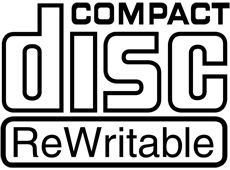CD-RW Information
CD-RW, or Compact Disc ReWritable, is a CD format that provides flexible recording options. This format permits optical data to be written, re-written, read, and erased multiple times.
When it was first conceived, it was known as CD-E (CD-Erasable) but was introduced in 1997 as an extension of the Orange Book standard as CD-RW. This media is designed for computer storage and backup since they can be re-written, but their re-writable format results in a disc with a smaller storage capacity than a CD-R, which can only be written once.

It’s predecessor, the CD-MO, launched in 1988 and shared similar form and function. However, it did not take off due to a lack of standards and quality along with the introduction of the more cost-effective CD-R.
A CD-RW’s basic composition parallels that of a standard CD, but due to its re-write function it includes a six-layer design. It has a polycarbonate layer designed with pre-grooves for the laser to track. Then it is topped with a layer of zinc sulfide and silicone dioxide. Subsequently, a recording layer is placed on top and made with alloyed silver, indium, tellurium, and antimony. The next layer is another coat of zinc sulfide and silicone dioxide. These two chemical compounds serve as dielectrics—or electric insulators to remove excess heat from the recording layer. A thin aluminum layer serves as the reflective surface for the burner’s laser beam. Each CD-RW disc is finished with a shiny acrylic top coat.
The mixture of compounds in the CD-RW’s recording layer when heated by a laser beam can change into three different states depending on the laser’s temperature. Heated to the laser’s highest temperature will write data into the recording layer. The laser’s second power is high enough to melt any recorded data which erases it, while maintaining the integrity of the layer for future re-writes. At this erase temperature, the layer converts into a crystalline state responsible for reflection. Compatible disc drives also contain a blanking option as a necessary step to re-recording. The lowest laser beam temperature will not alter the layer, but simply read the disc’s data.
CD-RW has extremely specific requirements for writing speeds. They operate within a confined speed range because if they’re too slow or too fast the laser’s high or low energy levels will not properly record data. The reading speed of CD-RW is not related to this issue and instead depends on what the drive offers.
CD-RW drives are versatile in that they can record data for CD-R and CD-RW. After 1997, CD-ROM drives needed MultiRead support to be compatible with CD-RW.

